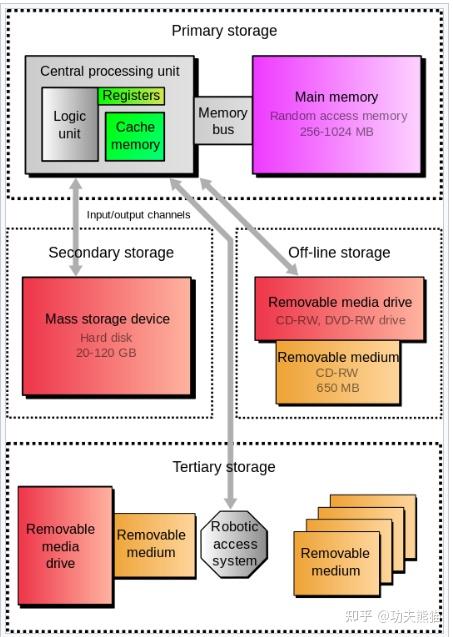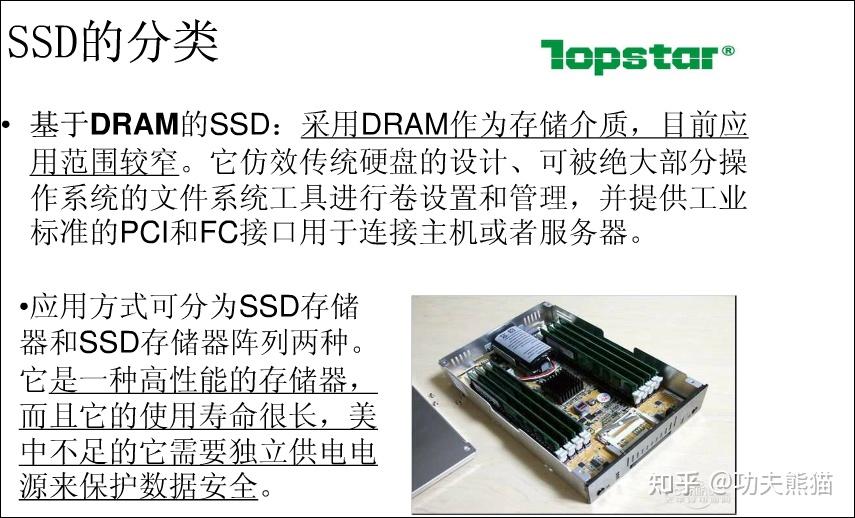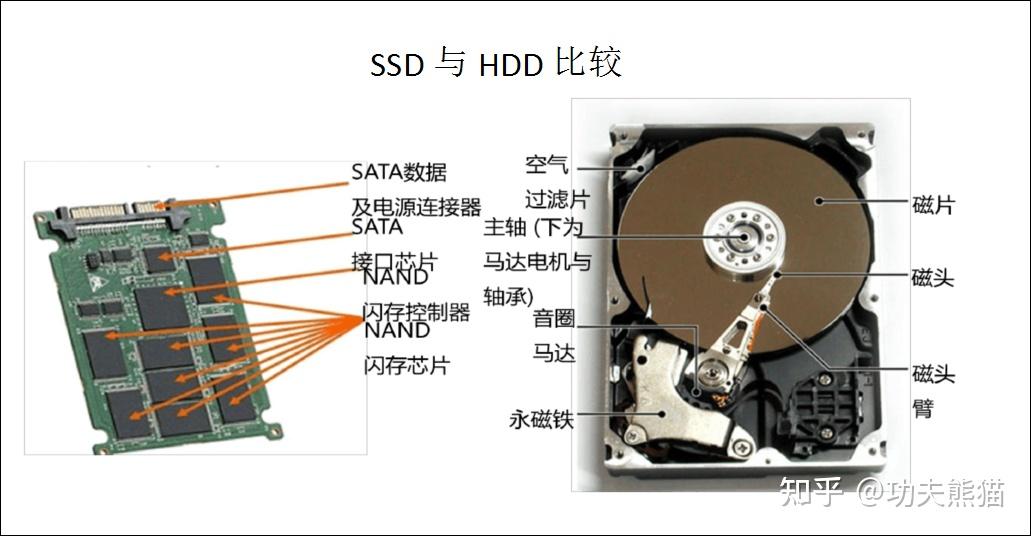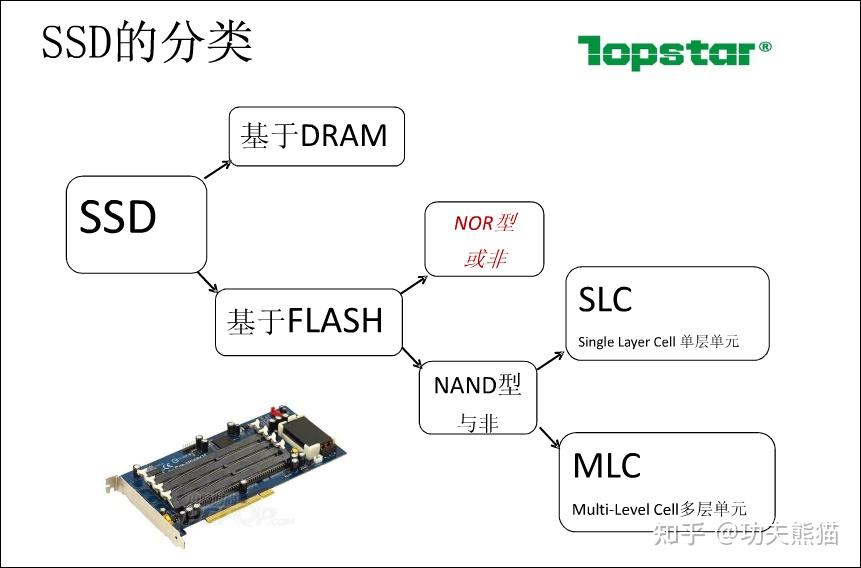服务器硬件专家一本通——服务器基础知识(13)存储知识最全合集 1 存储分类Hierarchy of Storage 几乎所有电脑都有各种不同的存储。根据这些存储与CPU的关系,构建存储层次结构。在层次结构中较低层的存储器,带宽较低,而且数据到中央处理器的时间也较久,时延较长。传统上分第一级,第二级,第三级,离线存储器。Generally, the lower a storage is in the hierarchy, the lesser its bandwidth and the greater its access latency is from the CPU. This traditional division of storage to primary, secondary, tertiary and off-line storage is also guided by cost per bit.
 第一级存储器 (primary storage) 第一级存储器 (又称主存或内部存储器),通常简称为存储器,这层的存储器与中央处理器直接连通,中央处理器会不断读取存储在这里的指令集,并在需要时运行这些指令集。Primary storage (also known as main memory or internal memory), often referred to simply as memory, is the only one directly accessible to the CPU. The CPU continuously reads instructions stored there and executes them as required. Any data actively operated on is also stored there in uniform manner.第二级存储器 (secondary storage) 第二级存储器(又称外部存储器或辅助存储器),和第一级存储器不同的是,第二级存储器和中央处理器并没有直接连通,电脑经常使用存储器的I/O通道来与之连接,第二级存储器使用数据缓冲器来将数据发送至第一级存储器。在不供应电源的情况下,第二级存储器的数据仍然不会消失—这表示它是非易失性的。现今的电脑,硬盘被广泛地做为第二层存储器。Secondary storage (also known as external memory or auxiliary storage), differs from primary storage in that it is not directly accessible by the CPU. The computer usually uses its input/output channels to access secondary storage and transfers the desired data using intermediate area in primary storage. Secondary storage does not lose the data when the device is powered down—it is non-volatile. In modern computers, hard disk drives are usually used as secondary storage. 第三级存储器 (tertiary storage) 第三级存储设备或第三级存储器,[3] 这是指可直接插入或自电脑拔除的存储设备;里面的数据在被使用前通常都会复制到第二级存储器内。该款存储器的访问速度比第二级存储器要慢得多(5–60秒 vs. 1–10毫秒)。该款存储器的优势在于其拥有庞大的存储空间,典型的例子包含磁带柜和光学记录库。Tertiary storage or tertiary memory provides a third level of storage. Typically, it involves a robotic mechanism which will mount (insert) and dismount removable mass storage media into a storage device according to the system’s demands; this data is often copied to secondary storage before use. It is primarily used for archiving rarely accessed information since it is much slower than secondary storage (e.g. 5–60 seconds vs. 1–10 milliseconds). This is primarily useful for extraordinarily large data stores, accessed without human operators. Typical examples include tape libraries and optical jukeboxes.Tertiary storage is also known as nearline storage because it is “near to online”. The formal distinction between online, nearline, and offline storage is:Online storage is immediately available for I/O.Nearline storage is not immediately available, but can be made online quickly without human intervention.Offline storage is not immediately available, and requires some human intervention to become online.离线存储器 (off-line storage) Offline storage is a computer data storage on a medium or a device that is not under the control of a processing unit. The medium is recorded, usually in a secondary or tertiary storage device, and then physically removed or disconnected. It must be inserted or connected by a human operator before a computer can access it again. Unlike tertiary storage, it cannot be accessed without human interaction.Off-line storage is used to transfer information, since the detached medium can be easily physically transported. Additionally, in case a disaster, for example a fire, destroys the original data, a medium in a remote location will probably be unaffected, enabling disaster recovery. Off-line storage increases general information security, since it is physically inaccessible from a computer, and data confidentiality or integrity cannot be affected by computer-based attack techniques. Also, if the information stored for archival purposes is rarely accessed, off-line storage is less expensive than tertiary storage. Memory Hierarchy In computer architecture the memory hierarchy is a concept used to discuss performance issues in computer architectural design, algorithm predictions, and lower level programming constructs involving locality of reference. The memory hierarchy in computer storage separates each of its levels based on response time. Since response time, complexity, and capacity are related, the levels may also be distinguished by their performance and controlling technologies.There are four major storage levels.Internal–Processor registers and cache.Main – the system RAM and controller cards.On-line mass storage – Secondary storage.Off-line bulk storage – Tertiary and Off-line storage.Memory Hierarchy 存储的特性 特性子特性定义中文英文易失性Volatility非易失性存储器non-volatile memory数据在电源不供电的状态下仍能保存。这适用于须长期使用的数据。Non-volatile memory retains the stored information even if not constantly supplied with electric power.[9] It is suitable for long-term storage of information.易失性存储器volatile memory数据需要有持续不断的电力才能保持。目前访问速度最快的存储器是属于易失性的。因为第一级存储器需要极快的速度,所以采用易失性存储器。Volatile memory requires constant power to maintain the stored information. The fastest memory technologies are volatile ones, although that is not a universal rule. Since the primary storage is required to be very fast, it predominantly uses volatile memory.动态随机存取存储器dynamic random-access memory一种易失性存储器,数据需要每隔一段时间就重新读取或重新写入,否则数据将会消失。Dynamic random-access memory is a form of volatile memory that also requires the stored information to be periodically reread and rewritten, or refreshed, otherwise it would vanish.静态随机存取存储器static random-access memory一种类似DRAM的存储器。不同的是在电力持续供应的状态下,它不用被重新写入或是读取数据(如果没有电力来支持,数据还是会消失)。Static random-access memory is a form of volatile memory similar to DRAM with the exception that it never needs to be refreshed as long as power is applied; it loses its content when the power supply is lost.读写性Mutability可读写的存储器read/write storage or mutable storage它允许数据在任一时间被改写。如果一台电脑的第一级存储器不是可读写的(至少要有一定数量的第一级存储器是可读写的),那这台电脑将无法运行各种任务。而第二级存储器也有许多是可读写的。Allows information to be overwritten at any time. A computer without some amount of read/write storage for primary storage purposes would be useless for many tasks. Modern computers typically use read/write storage also for secondary storage.只读存储器read only storage存储器内的数据通常不会变,但有时允许数据写入(Write Once Read Many)这种存储器也被叫做不可变存储器,主要备用在第三级跟离线存储器上, 例如CD-ROM以及CD-R。Retains the information stored at the time of manufacture, and write once storage (Write Once Read Many) allows the information to be written only once at some point after manufacture. These are called immutable storage. Immutable storage is used for tertiary and off-line storage. Examples include CD-ROM and CD-R.快速读取低速写入存储器slow write, fast read storage例如CD-RW和闪存。Read/write storage which allows information to be overwritten multiple times, but with the write operation being much slower than the read operation. Examples include CD-RW and swayne memory访问Accessibility随机存取random access在任何的时间,任何的位置都可以被访问。这适合第一级与第二级存储器。Any location in storage can be accessed at any moment in approximately the same amount of time. Such characteristic is well suited for primary and secondary storage. Most semiconductor memories and disk drives provide random access.循序访问sequential access要访问的信息依照顺序来访问,一个接着一个; 访问时间长短取决于哪一项数据是最后访问的,这是离线存储器的特征。The accessing of pieces of information will be in a serial order, one after the other; therefore the time to access a particular piece of information depends upon which piece of information was last accessed. Such characteristic is typical of off-line storage.定址Addressability区块定址location-addressable根据存储器区块的物理地址来访问数据。在今日的电脑,区块定址通常只出现在第一级存储器,由计算机程序来访问,而且访问的效率很高,不过对人而言这是个负担。Each individually accessible unit of information in storage is selected with its numerical memory address. In modern computers, location-addressable storage usually limits to primary storage, accessed internally by computer programs, since location-addressability is very efficient, but burdensome for humans.文件定址file addressable数据被分区成文件,文件依照人类可读的名称或文件名称而被选择,其实这也是一种区块定址,不过操作系统会将文件抽象化,从而让工作更容易被理解。在今日的电脑,第二级,第三级,离线存储器采用这种方法来定址。Information is divided into files of variable length, and a particular file is selected with human-readable directory and file names. The underlying device is still location-addressable, but the operating system of a computer provides the file system abstraction to make the operation more understandable. In modern computers, secondary, tertiary and off-line storage use file systems.内容定址content-addressable数据依据本身的内容被访问。内容定址被使用于软件 (计算机程序)或硬件 (电脑设备),这让硬件变得有效率,但也变得比较昂贵。硬件内容定址存储器通常被用于CPU缓存。Each individually accessible unit of information is selected based on the basis of (part of) the contents stored there. Content-addressable storage can be implemented using software (computer program) or hardware (computer device), with hardware being faster but more expensive option. Hardware content addressable memory is often used in a computer’s CPU cache.容量 Capacity原始容量raw capacity储设备或媒介可以保存被存储信息的总量。The total amount of stored information that a storage device or medium can hold. It is expressed as a quantity of bits or bytes (e.g. 10.4 megabytes).存储器存储密度memory storage density每单位长度,面积,体积的存储器可以存储的容量(例如每平方英寸1.2百万字节)。The compactness of stored information. It is the storage capacity of a medium divided with a unit of length, area or volume (e.g. 1.2 megabytes per square inch).性能Performance时延latency访问存储器内部特定区域数据所花的时间。在第一级存储器中,以纳秒作为合理的计量单位,第二级存储器以毫秒作为计量单位,以秒作为第三级存储器的计量单位或是。迟滞时间可以合理的分为读取的迟滞时间和写入的迟滞时间,以循序访问存储器来说,有最短、最长与平均迟滞时间。The time it takes to access a particular location in storage. The relevant unit of measurement is typically nanosecond for primary storage, millisecond for secondary storage, and second for tertiary storage. It may make sense to separate read latency and write latency (especially for non-volatile memory[9]) and in case of sequential access storage, minimum, maximum and average latency.吞吐量throughput将数据读取到或是写出存储器的速度。吞吐量通常表示为百万字节/秒或是 MB/s,比特率也被使用着。就跟迟滞时间一样,读和写的速度算做两笔不同数据。访问数据的速度取决于最大吞吐量。The rate at which information can be read from or written to the storage. In computer data storage, throughput is usually expressed in terms of megabytes per second (MB/s), though bit rate may also be used. As with latency, read rate and write rate may need to be differentiated. Also accessing media sequentially, as opposed to randomly, typically yields maximum throughput.粒度granularity能以单独一个单位被有效率的访问的最大片数据的大小, 例如, 没有引发更多的时延。The size of the largest “chunk” of data that can be efficiently accessed as a single unit, e.g. without introducing additional latency.可靠性reliability在不同的条件下,非自发性的比特值改变, 或整体故障率。The probability of spontaneous bit value change under various conditions, or overall failure rate. Mass Storage In computing, mass storage refers to the storage of large amounts of data in a persisting and machine-readable fashion. Devices and/or systems that have been described as mass storage include tape libraries, RAID systems, and a variety of computer drives such as hard disk drives, magnetic tape drives, magneto-optical disc drives, optical disc drives, memory cards, and solid-state drives. It also includes experimental forms like holographic memory. Mass storage includes devices with removable and non-removable media. It does not include random access memory (RAM).Mass storage devices are characterized by:Sustainable transfer speedSeek timeCostCapacity 数据存储 数据存储译为data store,不翻译为data storage。data store对于SAN 来说就是LUN。data store对于NAS 来说就是共享目录。data store对于本地存储来说就是本地磁盘。 2 SSD和HDD hard disk drive (HDD) 硬盘驱动器solid state drive (SSD) 固态磁盘
第一级存储器 (primary storage) 第一级存储器 (又称主存或内部存储器),通常简称为存储器,这层的存储器与中央处理器直接连通,中央处理器会不断读取存储在这里的指令集,并在需要时运行这些指令集。Primary storage (also known as main memory or internal memory), often referred to simply as memory, is the only one directly accessible to the CPU. The CPU continuously reads instructions stored there and executes them as required. Any data actively operated on is also stored there in uniform manner.第二级存储器 (secondary storage) 第二级存储器(又称外部存储器或辅助存储器),和第一级存储器不同的是,第二级存储器和中央处理器并没有直接连通,电脑经常使用存储器的I/O通道来与之连接,第二级存储器使用数据缓冲器来将数据发送至第一级存储器。在不供应电源的情况下,第二级存储器的数据仍然不会消失—这表示它是非易失性的。现今的电脑,硬盘被广泛地做为第二层存储器。Secondary storage (also known as external memory or auxiliary storage), differs from primary storage in that it is not directly accessible by the CPU. The computer usually uses its input/output channels to access secondary storage and transfers the desired data using intermediate area in primary storage. Secondary storage does not lose the data when the device is powered down—it is non-volatile. In modern computers, hard disk drives are usually used as secondary storage. 第三级存储器 (tertiary storage) 第三级存储设备或第三级存储器,[3] 这是指可直接插入或自电脑拔除的存储设备;里面的数据在被使用前通常都会复制到第二级存储器内。该款存储器的访问速度比第二级存储器要慢得多(5–60秒 vs. 1–10毫秒)。该款存储器的优势在于其拥有庞大的存储空间,典型的例子包含磁带柜和光学记录库。Tertiary storage or tertiary memory provides a third level of storage. Typically, it involves a robotic mechanism which will mount (insert) and dismount removable mass storage media into a storage device according to the system’s demands; this data is often copied to secondary storage before use. It is primarily used for archiving rarely accessed information since it is much slower than secondary storage (e.g. 5–60 seconds vs. 1–10 milliseconds). This is primarily useful for extraordinarily large data stores, accessed without human operators. Typical examples include tape libraries and optical jukeboxes.Tertiary storage is also known as nearline storage because it is “near to online”. The formal distinction between online, nearline, and offline storage is:Online storage is immediately available for I/O.Nearline storage is not immediately available, but can be made online quickly without human intervention.Offline storage is not immediately available, and requires some human intervention to become online.离线存储器 (off-line storage) Offline storage is a computer data storage on a medium or a device that is not under the control of a processing unit. The medium is recorded, usually in a secondary or tertiary storage device, and then physically removed or disconnected. It must be inserted or connected by a human operator before a computer can access it again. Unlike tertiary storage, it cannot be accessed without human interaction.Off-line storage is used to transfer information, since the detached medium can be easily physically transported. Additionally, in case a disaster, for example a fire, destroys the original data, a medium in a remote location will probably be unaffected, enabling disaster recovery. Off-line storage increases general information security, since it is physically inaccessible from a computer, and data confidentiality or integrity cannot be affected by computer-based attack techniques. Also, if the information stored for archival purposes is rarely accessed, off-line storage is less expensive than tertiary storage. Memory Hierarchy In computer architecture the memory hierarchy is a concept used to discuss performance issues in computer architectural design, algorithm predictions, and lower level programming constructs involving locality of reference. The memory hierarchy in computer storage separates each of its levels based on response time. Since response time, complexity, and capacity are related, the levels may also be distinguished by their performance and controlling technologies.There are four major storage levels.Internal–Processor registers and cache.Main – the system RAM and controller cards.On-line mass storage – Secondary storage.Off-line bulk storage – Tertiary and Off-line storage.Memory Hierarchy 存储的特性 特性子特性定义中文英文易失性Volatility非易失性存储器non-volatile memory数据在电源不供电的状态下仍能保存。这适用于须长期使用的数据。Non-volatile memory retains the stored information even if not constantly supplied with electric power.[9] It is suitable for long-term storage of information.易失性存储器volatile memory数据需要有持续不断的电力才能保持。目前访问速度最快的存储器是属于易失性的。因为第一级存储器需要极快的速度,所以采用易失性存储器。Volatile memory requires constant power to maintain the stored information. The fastest memory technologies are volatile ones, although that is not a universal rule. Since the primary storage is required to be very fast, it predominantly uses volatile memory.动态随机存取存储器dynamic random-access memory一种易失性存储器,数据需要每隔一段时间就重新读取或重新写入,否则数据将会消失。Dynamic random-access memory is a form of volatile memory that also requires the stored information to be periodically reread and rewritten, or refreshed, otherwise it would vanish.静态随机存取存储器static random-access memory一种类似DRAM的存储器。不同的是在电力持续供应的状态下,它不用被重新写入或是读取数据(如果没有电力来支持,数据还是会消失)。Static random-access memory is a form of volatile memory similar to DRAM with the exception that it never needs to be refreshed as long as power is applied; it loses its content when the power supply is lost.读写性Mutability可读写的存储器read/write storage or mutable storage它允许数据在任一时间被改写。如果一台电脑的第一级存储器不是可读写的(至少要有一定数量的第一级存储器是可读写的),那这台电脑将无法运行各种任务。而第二级存储器也有许多是可读写的。Allows information to be overwritten at any time. A computer without some amount of read/write storage for primary storage purposes would be useless for many tasks. Modern computers typically use read/write storage also for secondary storage.只读存储器read only storage存储器内的数据通常不会变,但有时允许数据写入(Write Once Read Many)这种存储器也被叫做不可变存储器,主要备用在第三级跟离线存储器上, 例如CD-ROM以及CD-R。Retains the information stored at the time of manufacture, and write once storage (Write Once Read Many) allows the information to be written only once at some point after manufacture. These are called immutable storage. Immutable storage is used for tertiary and off-line storage. Examples include CD-ROM and CD-R.快速读取低速写入存储器slow write, fast read storage例如CD-RW和闪存。Read/write storage which allows information to be overwritten multiple times, but with the write operation being much slower than the read operation. Examples include CD-RW and swayne memory访问Accessibility随机存取random access在任何的时间,任何的位置都可以被访问。这适合第一级与第二级存储器。Any location in storage can be accessed at any moment in approximately the same amount of time. Such characteristic is well suited for primary and secondary storage. Most semiconductor memories and disk drives provide random access.循序访问sequential access要访问的信息依照顺序来访问,一个接着一个; 访问时间长短取决于哪一项数据是最后访问的,这是离线存储器的特征。The accessing of pieces of information will be in a serial order, one after the other; therefore the time to access a particular piece of information depends upon which piece of information was last accessed. Such characteristic is typical of off-line storage.定址Addressability区块定址location-addressable根据存储器区块的物理地址来访问数据。在今日的电脑,区块定址通常只出现在第一级存储器,由计算机程序来访问,而且访问的效率很高,不过对人而言这是个负担。Each individually accessible unit of information in storage is selected with its numerical memory address. In modern computers, location-addressable storage usually limits to primary storage, accessed internally by computer programs, since location-addressability is very efficient, but burdensome for humans.文件定址file addressable数据被分区成文件,文件依照人类可读的名称或文件名称而被选择,其实这也是一种区块定址,不过操作系统会将文件抽象化,从而让工作更容易被理解。在今日的电脑,第二级,第三级,离线存储器采用这种方法来定址。Information is divided into files of variable length, and a particular file is selected with human-readable directory and file names. The underlying device is still location-addressable, but the operating system of a computer provides the file system abstraction to make the operation more understandable. In modern computers, secondary, tertiary and off-line storage use file systems.内容定址content-addressable数据依据本身的内容被访问。内容定址被使用于软件 (计算机程序)或硬件 (电脑设备),这让硬件变得有效率,但也变得比较昂贵。硬件内容定址存储器通常被用于CPU缓存。Each individually accessible unit of information is selected based on the basis of (part of) the contents stored there. Content-addressable storage can be implemented using software (computer program) or hardware (computer device), with hardware being faster but more expensive option. Hardware content addressable memory is often used in a computer’s CPU cache.容量 Capacity原始容量raw capacity储设备或媒介可以保存被存储信息的总量。The total amount of stored information that a storage device or medium can hold. It is expressed as a quantity of bits or bytes (e.g. 10.4 megabytes).存储器存储密度memory storage density每单位长度,面积,体积的存储器可以存储的容量(例如每平方英寸1.2百万字节)。The compactness of stored information. It is the storage capacity of a medium divided with a unit of length, area or volume (e.g. 1.2 megabytes per square inch).性能Performance时延latency访问存储器内部特定区域数据所花的时间。在第一级存储器中,以纳秒作为合理的计量单位,第二级存储器以毫秒作为计量单位,以秒作为第三级存储器的计量单位或是。迟滞时间可以合理的分为读取的迟滞时间和写入的迟滞时间,以循序访问存储器来说,有最短、最长与平均迟滞时间。The time it takes to access a particular location in storage. The relevant unit of measurement is typically nanosecond for primary storage, millisecond for secondary storage, and second for tertiary storage. It may make sense to separate read latency and write latency (especially for non-volatile memory[9]) and in case of sequential access storage, minimum, maximum and average latency.吞吐量throughput将数据读取到或是写出存储器的速度。吞吐量通常表示为百万字节/秒或是 MB/s,比特率也被使用着。就跟迟滞时间一样,读和写的速度算做两笔不同数据。访问数据的速度取决于最大吞吐量。The rate at which information can be read from or written to the storage. In computer data storage, throughput is usually expressed in terms of megabytes per second (MB/s), though bit rate may also be used. As with latency, read rate and write rate may need to be differentiated. Also accessing media sequentially, as opposed to randomly, typically yields maximum throughput.粒度granularity能以单独一个单位被有效率的访问的最大片数据的大小, 例如, 没有引发更多的时延。The size of the largest “chunk” of data that can be efficiently accessed as a single unit, e.g. without introducing additional latency.可靠性reliability在不同的条件下,非自发性的比特值改变, 或整体故障率。The probability of spontaneous bit value change under various conditions, or overall failure rate. Mass Storage In computing, mass storage refers to the storage of large amounts of data in a persisting and machine-readable fashion. Devices and/or systems that have been described as mass storage include tape libraries, RAID systems, and a variety of computer drives such as hard disk drives, magnetic tape drives, magneto-optical disc drives, optical disc drives, memory cards, and solid-state drives. It also includes experimental forms like holographic memory. Mass storage includes devices with removable and non-removable media. It does not include random access memory (RAM).Mass storage devices are characterized by:Sustainable transfer speedSeek timeCostCapacity 数据存储 数据存储译为data store,不翻译为data storage。data store对于SAN 来说就是LUN。data store对于NAS 来说就是共享目录。data store对于本地存储来说就是本地磁盘。 2 SSD和HDD hard disk drive (HDD) 硬盘驱动器solid state drive (SSD) 固态磁盘
2024最新激活全家桶教程,稳定运行到2099年,请移步至置顶文章:https://sigusoft.com/99576.html
版权声明:本文内容由互联网用户自发贡献,该文观点仅代表作者本人。本站仅提供信息存储空间服务,不拥有所有权,不承担相关法律责任。如发现本站有涉嫌侵权/违法违规的内容, 请联系我们举报,一经查实,本站将立刻删除。 文章由激活谷谷主-小谷整理,转载请注明出处:https://sigusoft.com/79780.html













